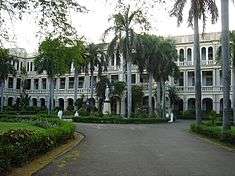Narayanan Chandrakumar
Narayanan Chandrakumar (born 1951) is an Indian chemical physicist and a professor of chemistry at the Indian Institute of Technology, Madras.[1] He is the founder of the first Nuclear magnetic resonance (NMR) laboratory in India and is known for developing a new technique for NMR imaging and diffusion measurements.[2] He is an elected fellow of the Indian National Science Academy[3] and the Indian Academy of Sciences[4] The Council of Scientific and Industrial Research, the apex agency of the Government of India for scientific research, awarded him the Shanti Swarup Bhatnagar Prize for Science and Technology, one of the highest Indian science awards, in 1996, for his contributions to chemical sciences.[5]
Narayanan Chandrakumar | |
|---|---|
| Born | 25 November 1951 Tamil Nadu, India |
| Nationality | Indian |
| Alma mater |
|
| Known for | Studies on rotating frame coherence transfer and Nuclear magnetic resonance |
| Awards | |
| Scientific career | |
| Fields | |
| Institutions |
|
| Doctoral advisor | |
Biography

N. Chandrakumar, born on 25 November 1951, in the south Indian state of Tamil Nadu, graduated in chemistry from Loyola College, Chennai in 1970 and completed his master's degree at IIT Madras in 1972.[1] His doctoral studies were at IIT Kanpur under the guidance of P. T. Narasimhan, a Shanti Swarup Bhatnagar laureate, which he completed in 1979 and joined Central Leather Research Institute (CLRI) as a research associate in 1980. He served the institute till 2001, holding positions such as that of a scientist, head of the Physical Sciences Division and a director-grade scientist and moved to IIT Madras where he is a professor at the department of chemistry. In between, he served as visiting scientist at JEOL, National Institutes of Health (1986), and at University of Siegen (1993). He also had visiting professorships at University of Ulm (1997–98) and INSERM, Grenoble (2001).[3]
Legacy
Chandrakumar is credited with the establishment of the first NMR laboratory in India which he accomplished during his early years at Central Leather Research Institute; later he would set up MRS and MRI facilities at IIT Madras.[3] He is the inventor of the new NMR imaging technique for diffusion measurements and has done studies on rotating frame coherence transfer and multiple quantum NMR, high resolution spin-1 NMR and spin-1 connectivity mapping.[6] He holds seven patents for the processes he has developed.[7] His researches have been detailed in two monographs, Modern techniques in high-resolution FT-NMR[8] and Spin-1 NMR[9] and several articles published in peer-reviewed journals;[10] ResearchGate, an online article repository, has listed 85 of them.[11] He has also edited the Magnetic Resonance, Diamond Jubilee Special Issue of the Proceedings (Chemical Sciences) of the Indian Academy of Sciences[12] and has supervised several doctoral scholars in their studies.[3]
Awards and honors
Chadrakumar received the Bruker Young Scientist Award in 1985 and two years later, received the Young Scientist Award of the Council of Scientific and Industrial Research in its first year in 1987.[3] CSIR honored him again 1996 with New Idea Fund Award and the Shanti Swarup Bhatnagar Prize, one of the highest Indian science awards, in 1996.[13] He was awarded the Millennium Medal by the Indian Science Congress Association in 2000 and the Chemical Research Society of India awarded him the Silver Medal in 2008.[14] The award orations he has delivered include Professor R. K. Asundi Memorial Lecture (2002) and the Professor K. Rangadhama Rao Memorial Lecture (2004) of the Indian National Science Academy and Professor N. Venkatasubramanian Endowment Lecture (2003).[15] The Indian Academy of Sciences elected him as their fellow in 1993[4] and he became a fellow of the Indian National Science Academy in 1997. He also held INSA-DFG Exchange Fellowship in 1988, Fellowship of the Max Planck Gesellschaft in 1989 and, 1990, INSA Visiting Fellowship for MRI / MRS Research at AIIMS in 1994, Honorary Senior Fellowship of the Jawaharlal Nehru Center for Advanced Scientific Research in 1997 and the J. C. Bose National Fellowship in 2009.[3]
References
- "Dr. N. Chandrakumar - Faculty profile". IIT Madras. 2016.
- "Brief Profile of the Awardee". Shanti Swarup Bhatnagar Prize. 2016. Retrieved 12 November 2016.
- "Indian fellow". Indian National Science Academy. 2016.
- "Fellow profile". Indian Academy of Sciences. 2016. Retrieved 12 November 2016.
- "View Bhatnagar Awardees". Shanti Swarup Bhatnagar Prize. 2016. Retrieved 12 November 2016.
- "Handbook of Shanti Swarup Bhatnagar Prize Winners" (PDF). Council of Scientific and Industrial Research. 1999. p. 34. Archived from the original (PDF) on 4 March 2016. Retrieved 5 October 2016.
- "Inventions and Patents". IIT Madras. 2016.
- Narayanan Chandrakumar; Sankaran Subramanian (1987). Modern techniques in high-resolution FT-NMR. Springer-Verlag. ISBN 978-0-387-96327-3.
- N. Chandrakumar (6 December 2012). Spin-1 NMR. Springer Science & Business Media. ISBN 978-3-642-61089-9.
- "Browse by Fellow". Indian Academy of Sciences. 2016.
- "N. Chandrakumar on ResearchGate". ResearchGate. 2016.
- "Books". IIT Madras. 2016.
- "Chemical Sciences". Council of Scientific and Industrial Research. 2016. Archived from the original on 12 September 2012. Retrieved 7 November 2016.
- "Awards: Year - 2008". Chemical Research Society of India. 2016. Archived from the original on 16 October 2016. Retrieved 26 November 2016.
- "Awards and honors". IIT Madras. 2016.
Further reading
- Narayanan Chandrakumar (2008). "Coherence Transfer in Spatially Resolved NMR (full text)". Magnetic Resonance Insights. 2: 25–41.